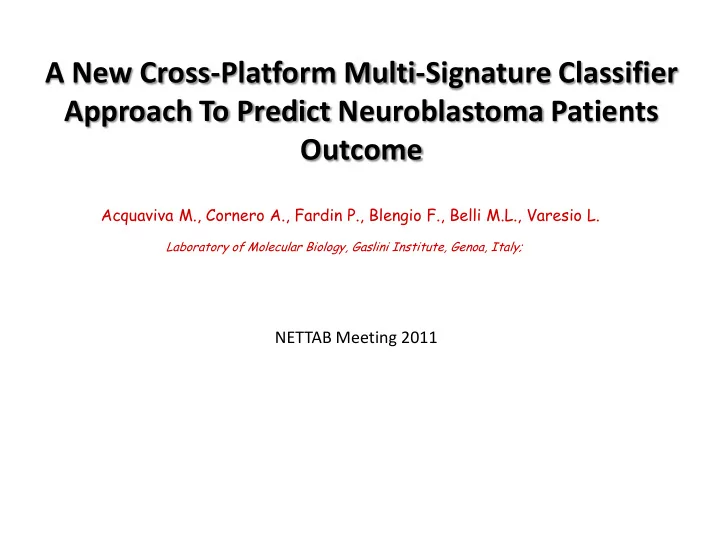

A New Cross-Platform Multi-Signature Classifier Approach To Predict Neuroblastoma Patients Outcome Acquaviva M., Cornero A., Fardin P., Blengio F., Belli M.L., Varesio L. Laboratory of Molecular Biology, Gaslini Institute, Genoa, Italy; NETTAB Meeting 2011
Background • Neuroblastoma is the most common pediatric solid tumor of the sympathetic nervous system • High variability in clinical behavior • Reliable patients outcome predictions are often difficult to assess Development of new predictive tools to assist established Neuroblastoma risk factors is mandatory
Background Previous Work Generation of a Multi-Signature Ensemble classifier for NeuroBlastoma patients outcome prediction ( NB-MuSE-classifier) Ability to take into account the biological and prognostic information derived from a-priori knowledge (gene expression signatures). Possibility to combine different machine learning algorithms prediction power. • 182 Neuroblastoma patients: U133Plus2 Gene Expression Profiles • 35 Neuroblastoma related gene signatures from literature • 22 Machine Learning algorithms tested NB-MuSE-classifier
Background Previous Work Results Promising preliminary results but Evaluation Limited by relatively small test dataset
Background The availability of samples is one important limiting factor in developing reliable prognostic classifiers, especially for rare tumors such as neuroblastoma. Neuroblastoma repositories are often characterized by heterogeneous high-througput datasets A multi-signature classification framework which can use different array datasets (different gene expression platforms, arrayCGH, etc.) to: • improve biological and prognostic a-priori information • extend the sample size used for validation
Generation of a cross-platform NB-MuSE-classifier Exon 1.0 ST U133Plus2 Data Ability to take into account the biological and prognostic information derived from a-priori knowledge (gene expression signatures). Possibility to combine different machine learning algorithms prediction power. Ability to be trained and tested on different type of high-throughput datasets (cross-platform feature), such as different gene expression arrays. This feature permits the integration of heterogeneous datasets and the extension of sample size used for validation.
Workflow for cross-platform NB-MuSE-classifier construction Exon 1.0 ST U133Plus2 Data • 162 new neuroblastoma patients: Affymetrix Exon 1.0 ST Array (gene level). • 20 neuroblastoma related gene signatures • 19 Machine Learning algorithms
DS1 trainingdataset (53 patients): one for each signature Expression dataset used to train the single signature classifiers to predict patients overall survival (Alive/Dead labels) …. Gene IDs
DS2 external validation dataset (53 patients): one for each signature Expression dataset used to validate the single signature classifiers trained on DS1 …. Gene IDs …. • Selection of the best single signature classifiers: evaluation prediction accuracy (>80%), sensitivity, specificity and recall.
DS2 transformed in Prediction Matrix (NB-MusE-classifier training set, 53 patients) Prediction matrix assembled from the predictions performed on DS2 by the best single-signature classifiers selected during the first phase …. Signature IDs ….
DS3 transformed in Prediction Matrix (NB-MusE-classifier validation set, 56 patients) Prediction matrix assembled from the predictions performed on DS3 by the best single-signature classifiers selected during the first phase …. Signature IDs …. DS2 and DS3 transformation steps are the core of the Cross Platform feature
Preliminary Results Cross-platform evaluation of Multi-Signature Classifiers performance. The resulting multi-signature classifiers have been cross-tested on the external datasets and the relative performance has been evaluated. The Exon based NB-MuSE-classifier showed higher stability and reliability across the test datasets. K-Star 60 patients 62 patients Decision-Table 53 patients 56 patients
Conclusions • We developed a new classification model based on Exon expression data testable on the prediction matrices previously assembled from U133Plus2 data • We successfully tested the cross-platform feature of NB-MuSE-classifier • We have been able to evaluate and compare the two classifiers performance on respectively 109 and 122 (DS2+DS3) new neuroblastoma patients.
Future Directions • Optimization of classifiers learning parameters and cross-validation set-ups • Optimization of a-priori information selection (NB-related signatures) • Test on randomized datasets • Integration of arrayCGH and miRNA datasets
Recommend
More recommend